
Fieldwork bulletin
Contributions to the news blog are welcome. See the guidance for contributors and contact Digital Manager Jacob Scott.
Search page
Search within this page here, search the collection page or search the website.
Index
- The Fieldwork Committee and the Fieldwork Forums
- Dover Archaeological Group
- Swalecliffe
- Maidstone Area Archaeological Group (MAAG)
- Canterbury Archaeological Trust (CAT)
- Kent Archaeological Fieldschool (KAFS)
- Orpington and District Archaeological Society (ODAS)
- Studying History and Archaeology in Lympne (SHAL)
- Faversham Society Archaeological Group
- Wye Historical Society
- Discovering Roman Otford Project
- Hastings Area Archaeological Group (HAARG)
- Feedback You said:
- Editor's comments
Intellectual property and the transition period
New Books
Fieldwork bulletin
The fieldwork committee provides on update on the newly formed Fieldwork Form, including presentations on the excavations from around Kent.
The Fieldwork Committee and the Fieldwork Forums
As part of the recent restructuring of the KAS, The Fieldwork Committee was slimmed down. Previously, the first part of its meetings was taken up with business and the second (longer) part by reports from those local society representatives who happened to sit on the Committee. These two elements have now been split; a small committee now deals with formal business while the Fieldwork Forums have been instigated as a way to facilitate sharing between reps from affiliated groups. This Bulletin is part of an attempt to widen the impact of the Forums.
We have now held two Forums. The first took place in Maidstone in May and the second in Canterbury on November 23. As Keith Parfitt, who chaired the latest meeting, pointed out, Kent is a large county and someone will always have to travel a considerable distance to participate. With this in mind, the Forums will move around the county. The next is scheduled to be held in Tonbridge, in March (details to be finalised).
It is fair to say that we are still finding our way with these events and we welcome feedback from participants. The first Forum was very unstructured. The latest meeting had more form, with brief presentations from a number of groups, followed by group discussion. Much of the latter centred on the need for good communication. Andrew Richardson also instigated a discussion on the correct use or otherwise of the term “Saxon”, the take-home points of which are that the term “Anglo-Saxon” is preferable and that whatever else they were, the people of East Kent “were not Saxons”.
The Forum was attended by representatives of 13 organisations and was held at Eliot College, by kind permission of the University of Kent. We heard a stimulating selection of presentations, several of which were accompanied by PowerPoints or other visual media as well as seeing some interesting finds. These presentations are outlined (with apologies for any deficiencies) below. Next time, I will ask participants to provide their own summaries for circulation via the Bulletin.
Dover Archaeological Group
Keith Parfitt summarised the activities of the Dover Group, who have taken part in the KAS excavations at Lees Court as well as participating in the University of Reading’s work at Lyminge.
Swalecliffe
Peter Slaughter described the work he has been conducting on the shore at Swalecliffe, where finds from bands of grey clay are occasional but significant. These include Bronze Age and Iron Age pottery, a goat skull and circular features, almost certainly wells. Environmental analysis has been undertaken and indicates the presence of ancient grasslands and the presence of livestock. Perhaps the most exciting finds are a withy tie and a wooden cleat. These have been carbon dated, the withy to 1742-1559 cal BCE and the cleat to 2194-1982 cal BCE. Peter is cautious about speculating that these are boat components, but if so, would be contemporary with Ferriby 3, the oldest known sea-going craft.
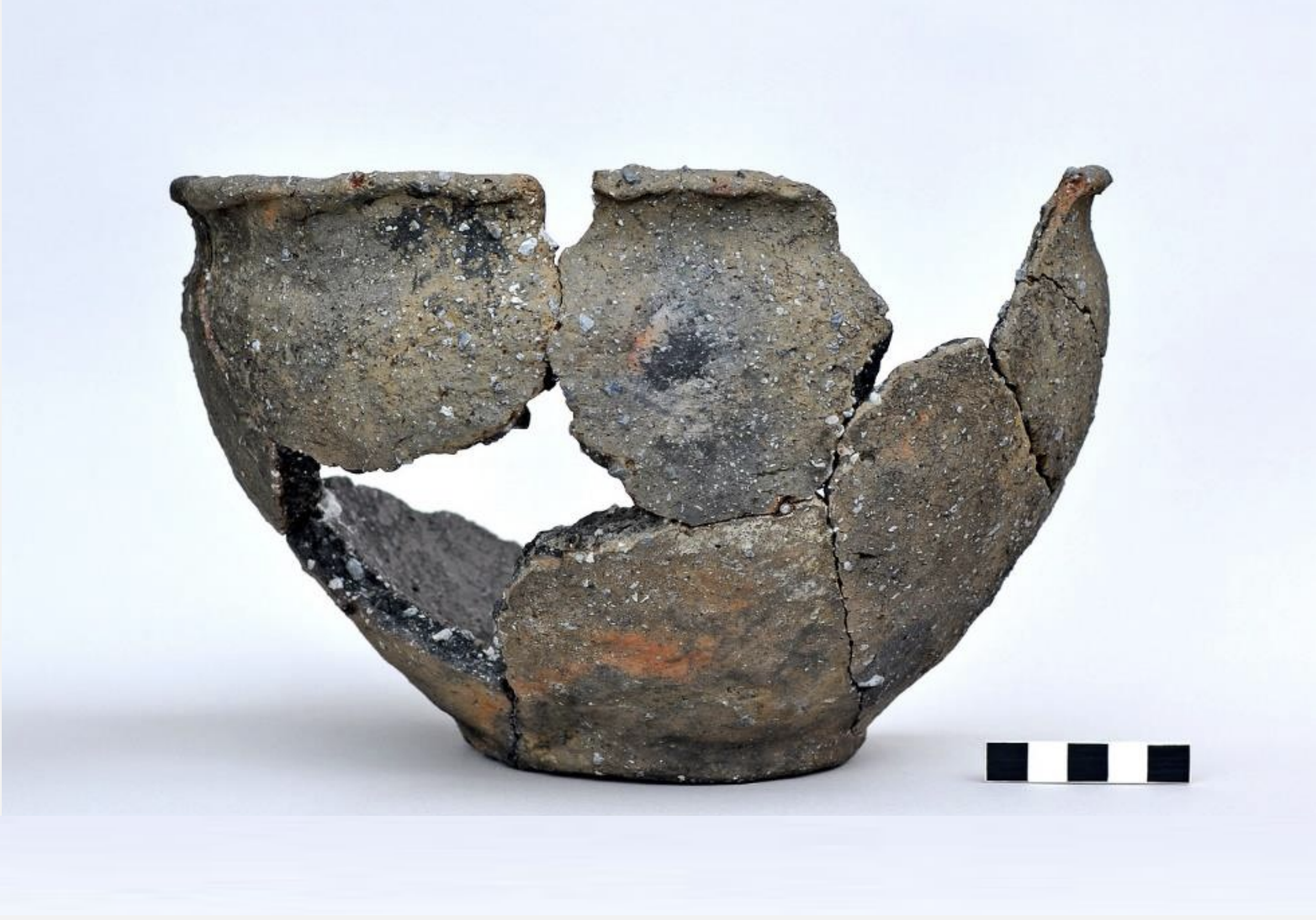
Iron Age pot assembled from sherds found from Summer 2009 to October 2010 in sediments at Swalecliffe. The scale is in centimetres.
Maidstone Area Archaeological Group (MAAG)
Stephen Clifton summarised this season’s work at East Farleigh. In previous years, the Group has excavated a complex of Roman buildings. With a change of ownership, this land is no longer available and the Group has been concentrating on an adjacent area when a potential Late Iron Age votive deposit and an oven-type feature have been found in previous years.
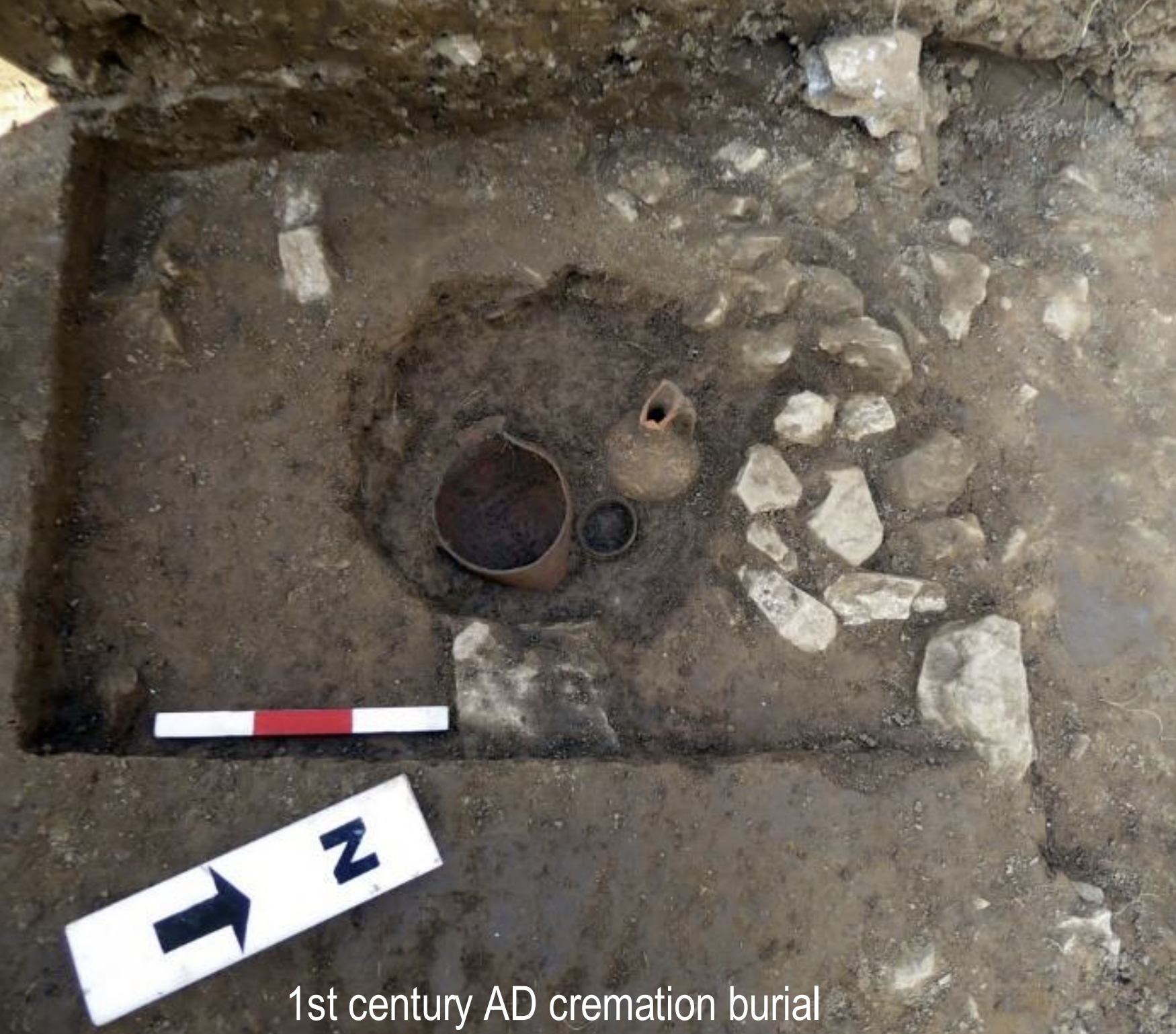
1st century AD cremation burial.
Magnetometry suggested several features which have proved somewhat elusive in excavation. Nevertheless, initial machining immediately came down upon the neck of a vessel which later proved to be part of a 1st century AD Roman cremation burial. The ”oven” proved to be a corndrier type feature, interesting both for containing what appears to be a sub-Roman votive deposit in the form of a 5th century pot and for having been adapted with a replacement flue. Two more 1st century furnished cremations were found in the same area.
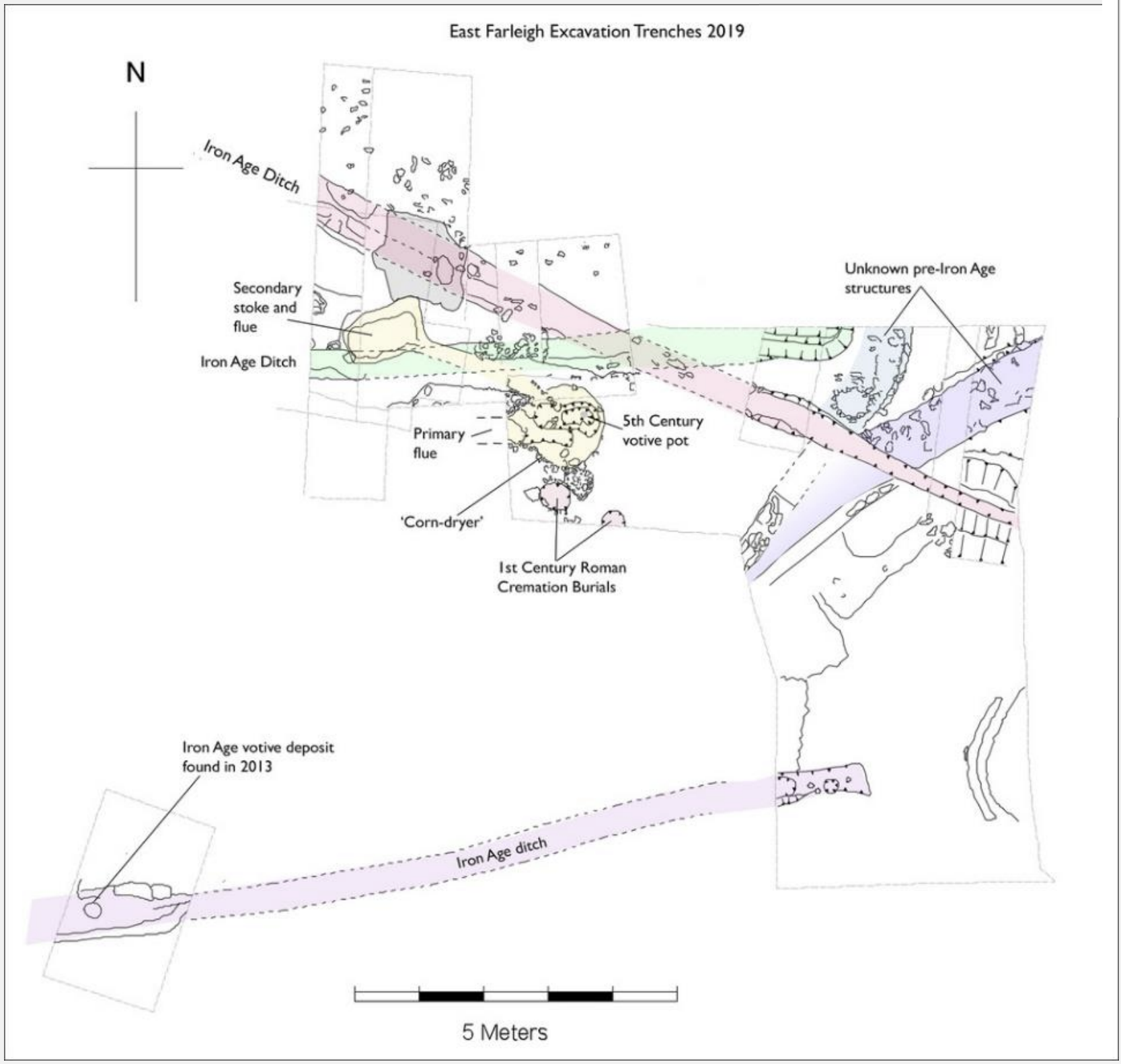
East Farleigh Excavation Trenches 2019.
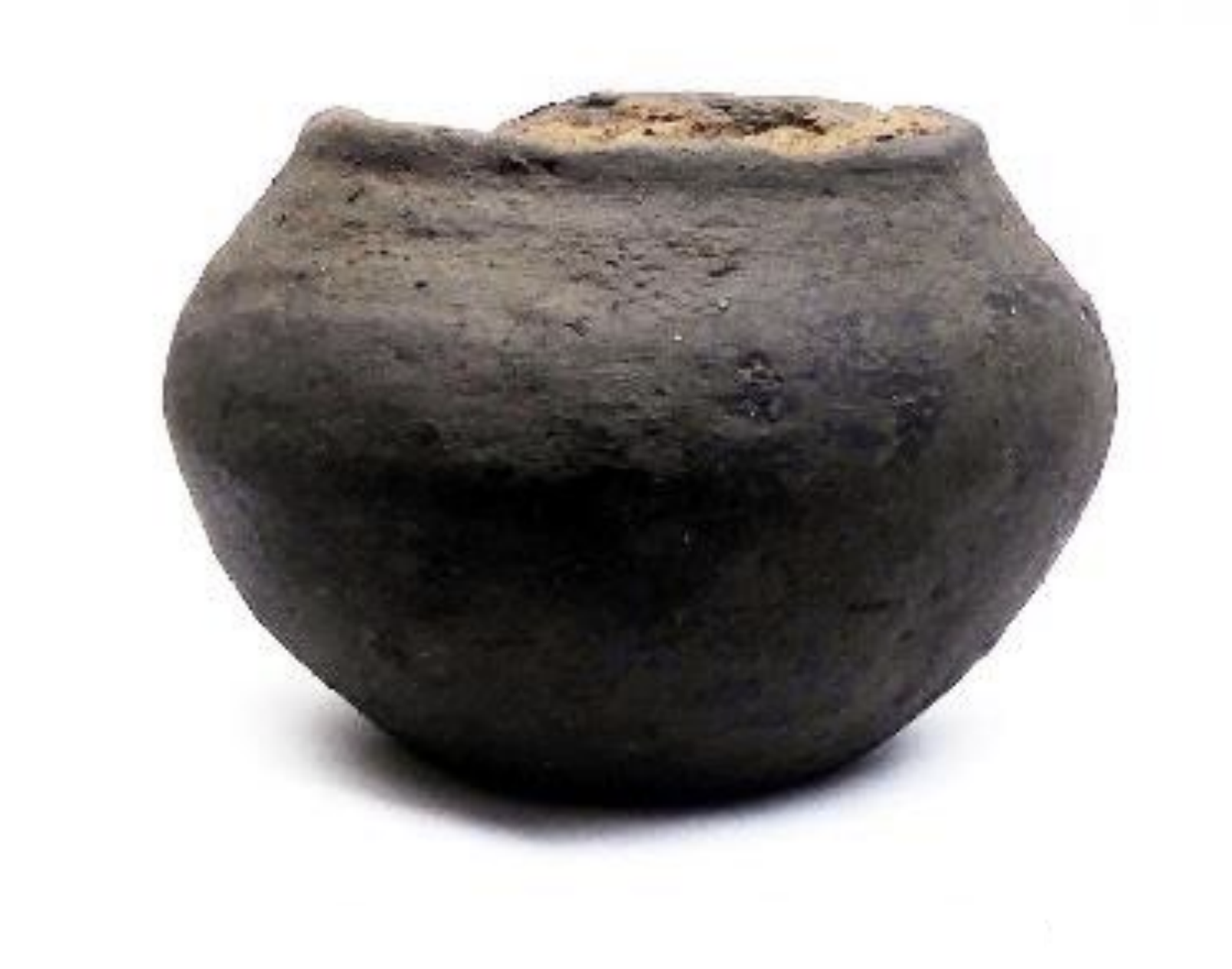
Votive pot found in a 'Corn-Drier' at East Farleigh 2019. Believed to be 5th century.
Canterbury Archaeological Trust (CAT)
Andrew Richardson described CAT’s new archaeological stores and teaching facilities before going on to talk about the community project, Finding Eanswythe, conducted in collaboration with Canterbury Christ Church University. Fieldwork has focused on St Eanswythe’s Water, an engineered watercourse which supplied fresh water to the people of Folkestone for centuries. Although legend has it that St Eanswythe, granddaughter of King Ethelbert, caused water to “run uphill”, from the Downs to the Bayle, evidence uncovered by the project suggests that the aqueduct was, in fact, a 13th century construction. The project was had great success recruiting volunteers new to archaeology.
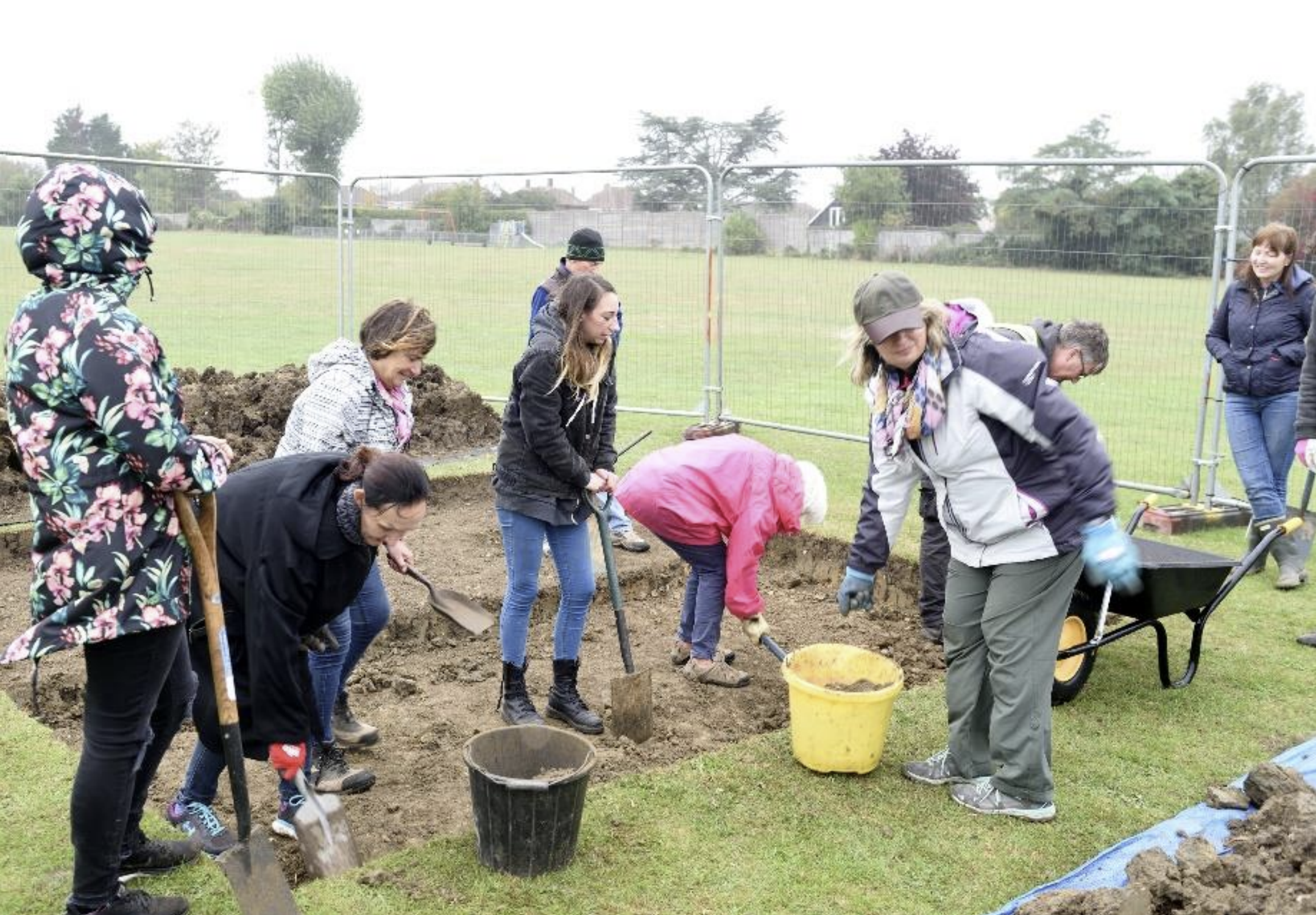
Excavating and recording St Eanswythe’s Water, Folkestone.
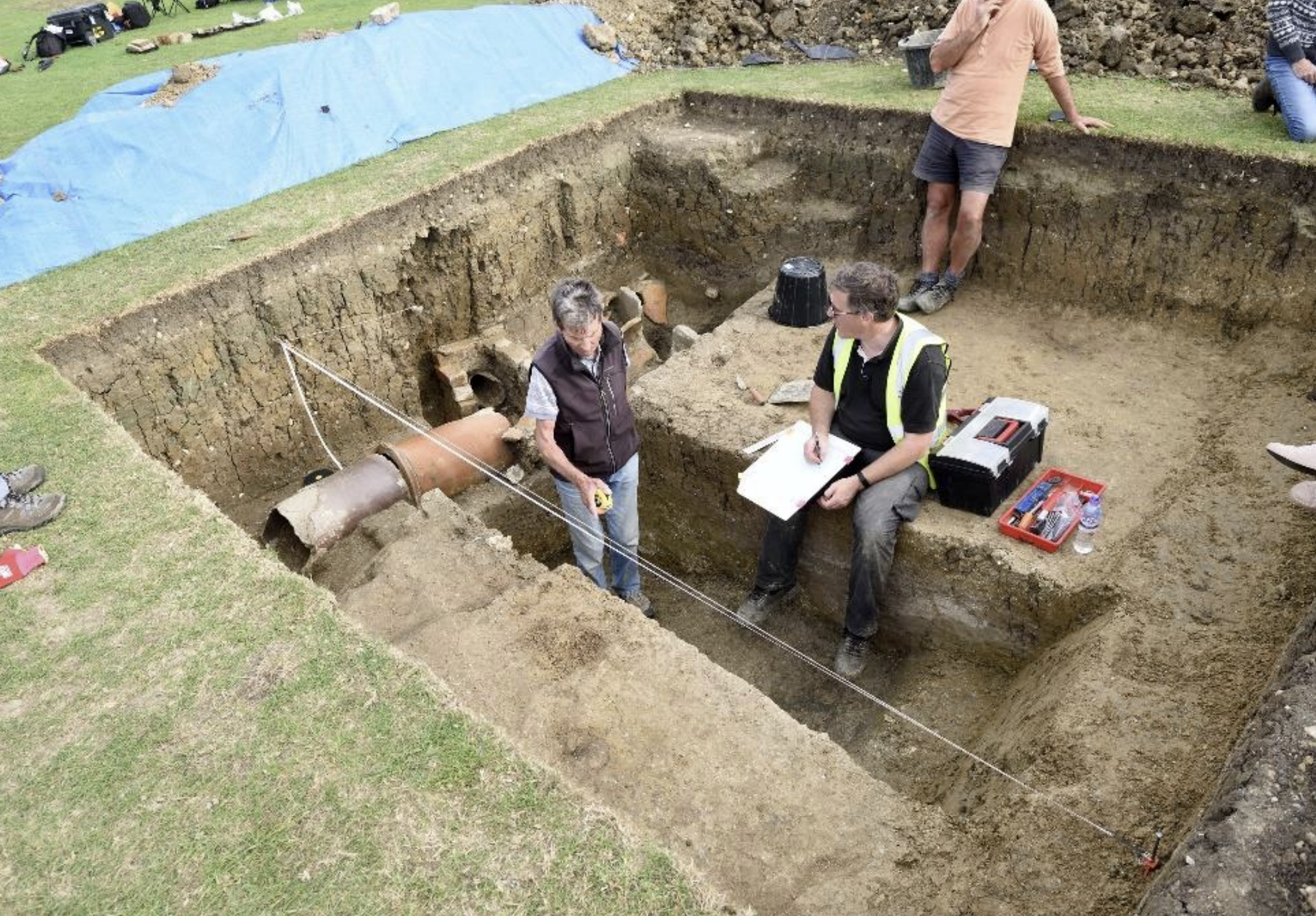
Excavating and recording St Eanswythe’s Water, Folkestone.
Andrew also described the recent discovery of a high status (probably royal) Anglo-Saxon female grave adjacent to and pre-dating St Augustine’s, Canterbury.

Anglo-Saxon silver, garnet-inlaid Kentish disc brooch (late 6th century AD).
Kent Archaeological Fieldschool (KAFS)
Paul Wilkinson described the genesis of KAFS. Having completed his PhD thesis on the historical development of the port of Faversham, he was commissioned by Swale Borough Council to carry out an archaeological survey of the Swale district, identifying many of the sites later excavated by KAFS. He was fortunate to be able to buy the oast where equipment was stored, and to gain permission to convert this into the field school’s present headquarters.
Orpington and District Archaeological Society (ODAS)
Janet Clayton described work carried out as part of the Society’s ongoing work at Scadbury Manor, a medieval moated manor site and estate whose archaeology spans the 13th century to the activities of the Home Guard. This years’ excavations have focused on exploring the size of the moat, which was found to have been partially backfilled in the Tudor period. This ancient backfill included a jetton manufactured between 1420 and 1500, thus dating to the period when Thomas Walsingham bought the Manor (1424).
Janet also related how the timbers from the dismantled Manor have recently come to light and been rescued from the Weald and Downland Museum. Their provenance had been lost and they were in danger of being discarded.
Studying History and Archaeology in Lympne (SHAL)
Fiona Jarvest described the group’s origins and forays into experimental archaeology. They first made a lime kiln and successfully created lime from Ragstone. They then decided to use the lime to build a Roman wall, but to do this they needed tiles, so they then built a tile kiln and made their own tiles. These have been used to build a plinth, overlooking Studfall Castle.
The group have worked with Malcolm Davies and Richard Taylor on geophysical surveys at Lympne and have joined the excavations at Lees Court.
Their most recent experimental efforts have been directed at making a replica Bronze Age axe. They were able to melt tin, but not copper and would welcome advice on how to progress the project.
Faversham Society Archaeological Group
John Clarkstone presented some highlights from the Group’s (well-publicised) excavations at the Market Inn in central Faversham where an Anglo-Saxon rubbish pit, thought to be associated with the lost royal manor, produced evidence of feasting and industrial activity. John displayed various finds including examples of iron slag (some 7-8kg recovered in all), part of a bone comb, pottery, glass beads, a pin and also a large number of hob nails.
The Group are also currently involved in cataloguing the Faversham Society’s collection of maps.
Wye Historical Society
Maureen de Saxe related that Wye Historical Society has had an influx of new members and are now hoping to become more active. They have a new site which has in the past been used for clay pits, hop gardens and brickworks but has now been returned to agricultural use. It is producing finds dating from the Neolithic through to Victorian and Maureen brought a selection of these for viewing. These included Neolithic blades and scrapers, medieval pottery and the top of a Roman flanged-neck flagon.
Discovering Roman Otford Project
The group are currently excavating a Roman villa, which Kevin Fromings described as being similar in size and layout to Lullingstone.
This season they have been working on a potential bath house with opus signinum floors and water pipes. This started life as a separate structure before being joined to the main building. The complex features a mixture of floor types, some tessellated, some just op sig and boasted hypocausts and painted wall plaster. Coin finds suggest occupation dates between AD 218 and AD 402. The east wing was never completed and the building seems to have been systematically dismantled.
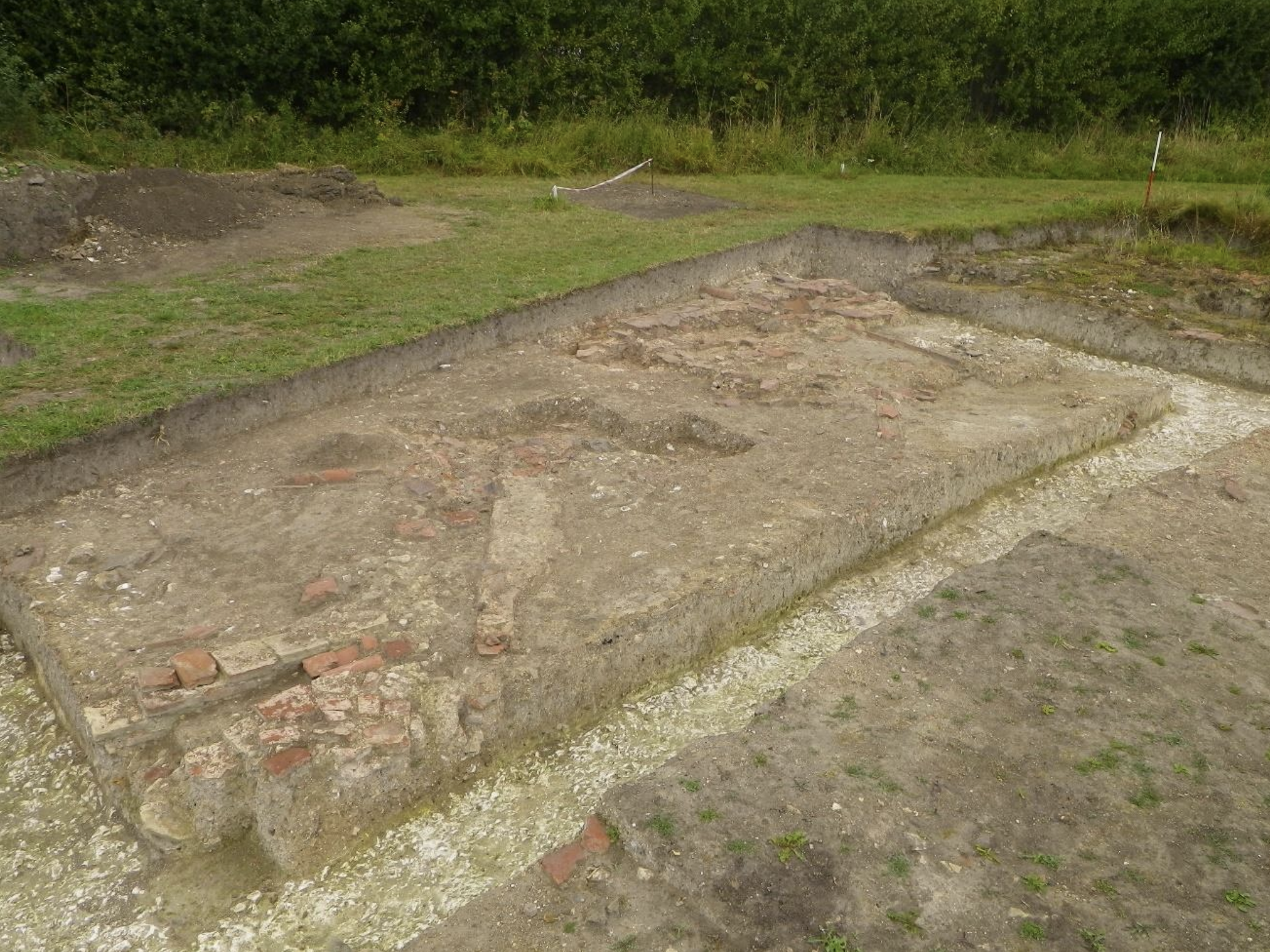
Roman bath house, Otford.
A particularly nice find was a complete pair of small, iron shears. It has been suggested they would have been suitable for beard trimming.
Hastings Area Archaeological Group (HAARG)
Although based in East Sussex, HAARG often work across the border in Kent. Lynn Cornwell gave a roundup of a number of sites investigated by the group and displayed some very impressive geophysical scan results.
The group have done work for the National Trust at Smallhythe Place, showing up some known medieval features, but also unsuspected Roman ones (corroborated by finds of CBM). They have found enclosures at Morgew Farm, Tenterden where metal detecting has produced finds of Bronze Age and Roman date as well as the footprint of the lost medieval manor of Forsham, near Rolvenden. Working on a project for the High Weald AONB, they have confirmed the location of a lost building Woodside Farm, Benenden which appeared on a historic map.
Filed walking and an initial magnetometer survey and at Northiam yielded exciting results indicating another significant Classis Britannica site, situated on an inlet, with substantial buildings, possibly two tile kilns and large quantities of stamped tile. Unfortunately, after the excavation of just one trench (which came down onto a probable bread oven) permission to access the site has been withdrawn by the land agent, concerned that the presence of archaeology will devalue the land.
The final project described was at Winchelsea, where geophysical survey has demonstrated unequivocally the former presence of a proto motte and bailey, the town ditch, post-windmill mound and medieval tenement plots.
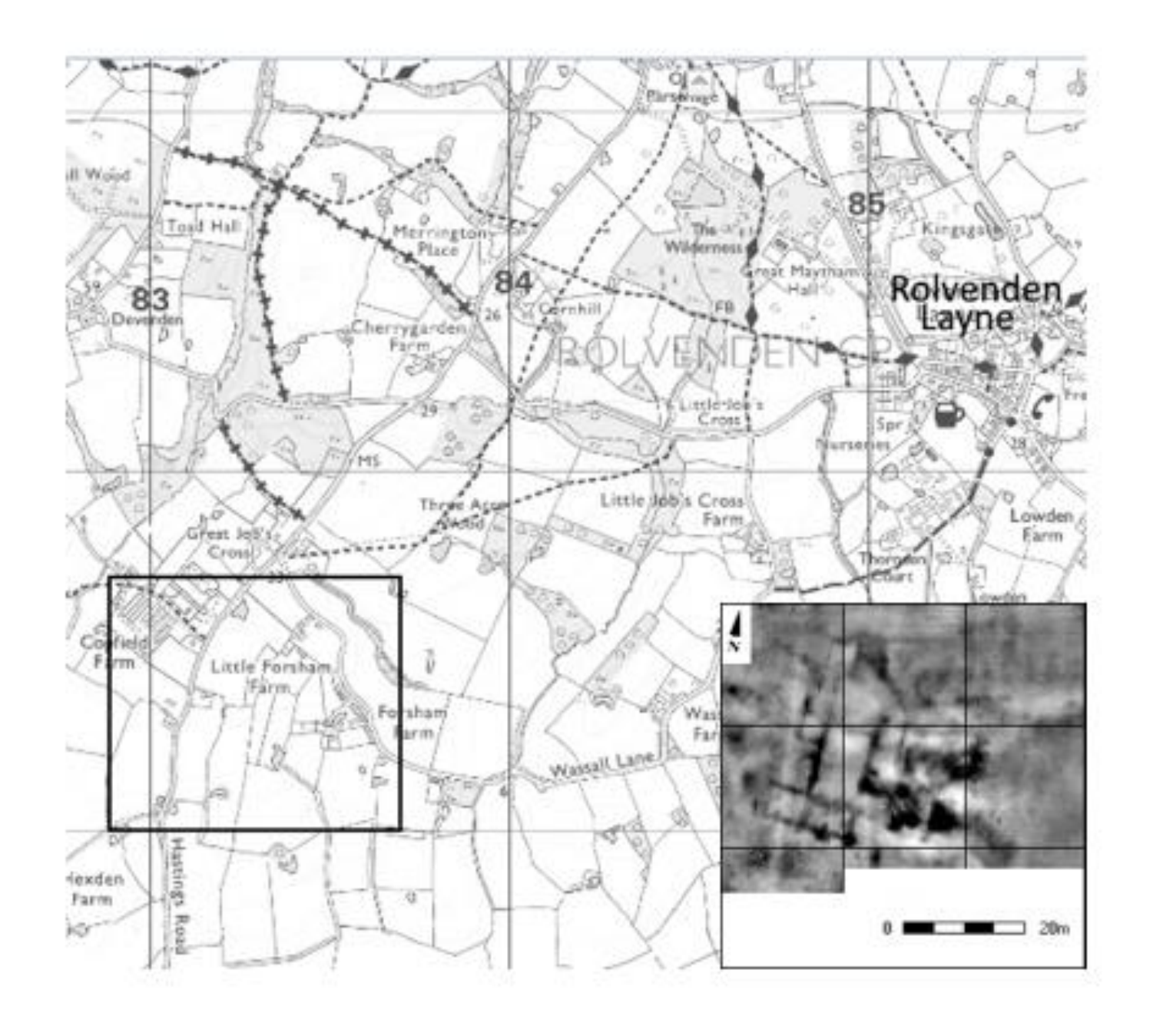
Forsham Manor, near Rolvenden.
HAARG are very happy to share their expertise and to work with other groups.
Feedback You said:
• “Very good format, mix of groups. Moving venue around the county may attract other groups to attend however this has not been that successful in Sussex – but the meetings are held weekday evening which makes travelling during the rush hour difficult. Saturday morning is far more sensible”.
• “Good morning – little more guidance on what facilities are available to speakers”.
• “All very good – but a short powerpoint presentation from all speakers would help”.
• “The programme today went really well. Full of interest; learned a great deal. Clearly there is a firm purpose and audience for such meetings, communicating the rich variety of projects being undertaken.”
• “Knowing what facilities are available (eg powerpoint) would be useful Would it be worth looking at structure of Sussex Archaeological Symposium but with more speakers, and shorter reports? On the whole a very worthwhile enterprise”.
• “I thought the lecture theatre was very good although it would have been helpful to have refreshments in the venue rather than some distance away in another building….A number of people, including me, did not realise projection equipment would be available both for Powerpoint and overhead….In addition, I wonder whether it is really necessary to have a different venue each time, or whether choosing one central location would be better, so that everyone gets to know where they are going….if attendance was going to be much bigger, which would be good, would it make sense for groups to be asked in advance if they want to do a presentation, rather than allocating a list of everyone there? Then give them a time limit which must be adhered to, so that there is more opportunity for discussion without over-running.
Editor's comments
Thank you to all who took the trouble to give us this very helpful feedback. We are listening and (I hope) learning.
• One problem is not knowing until relatively late in the day how many people will be attending/wanting to speak. We probably need to finalise this further in advance, so that we can allocate suitable times. This time I think we just about got away with it!
• Re facilities, you are all quite right. I don’t think we really anticipated PowerPoints (partly because we weren’t initially planning to use a lecture theatre, but circumstances dictated). Clearly, they enhanced the day. Such facilities may not be available at all potential venues, but that is something we will have to look to.
• Catering shortfall. I’m afraid this was unscheduled and unforeseen. There were staff shortages which meant that coffee couldn’t be brought over to Eliot on this occasion. Refreshments are important!
Edited by Elizabeth Blanning
